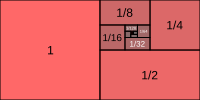 Since Adolf Hitler is a strongly condemned political leader, the circumstances around his rise to power are very interesting. Germany's desperation post-World War I, the Great Depression, hyperinflation and emerging communism promoted this process.Suffering after WWI
Since Adolf Hitler is a strongly condemned political leader, the circumstances around his rise to power are very interesting. Germany's desperation post-World War I, the Great Depression, hyperinflation and emerging communism promoted this process.Suffering after WWIWWI ended when the
Treaty of Versailles was signed. In it, the Allied countries required Germany to pay
war reparations,
surrender territory and reduce
the power of its defence forces. These provisions (along with a declaration to
surrender) were a large blow to Germany's
national pride. Also, the
indecisiveness of the democratic Weimar Republic meant that laws took a long time to be passed.
 This 1000 Reichsmark note was overstamped to a face value of 1 000 000 000 Reichsmark.
This 1000 Reichsmark note was overstamped to a face value of 1 000 000 000 Reichsmark.The German
economy suffered in two ways during some of this period. The country was required to pay currency as part of its reparations, which was financed substantially by
printing extra currency. This caused
hyperinflation of the Reichsmark, even during the
Great Depression following the US stock market crash. Face values fell well below the cost of the paper, leading to (among other things) persons' burning it as firewood during famine winters. Even though it ended after three years (with the introduction of the Rentenmark), a lack of popular confidence was cast on the
financial system (substantially comprised of
Jews).
Enter Hitler Hitler's DAP (predecessor to the Nazi Party) membership card.
Hitler's DAP (predecessor to the Nazi Party) membership card.Seeking
participation in politics, Hitler
joined the German Workers' Party (progressing to the NSDAP or
Nazi Party), which was notably
far-right in the political spectrum. It
promoted (among other things)
nationalism,
anti-communism,
economic recovery and
abandoning the Treaty (though the
anti-Semitism can be observed in the rhetoric). He possessed a demonstrated
charisma and easily
appealed to most of Germany's citizens. Hitler eventually became the
sole leader of the party.
The following
circumstances existed for the Weimar Republic:
- The system of government at this time was parliamentary republic under constitution, which made for several political parties to contend for the popular vote. In it, there was a President (elected by popular vote) who ceremonially signed bills into law, and a Chancellor (approved by parliament after nomination by the President) who led the party in government.
- The Weimar Constitution codified civil liberties such as habeas corpus (freedom from unlawful detainment), freedom of expression, freedom of association, privacy of telecommunication and protection of property and home.
- The Weimar Constitution allowed the President to issue decrees (which did not need parliamentary approval) in times of emergency.
- The Weimar Constitution placed limits on the laws that can be made, and any deviation was considered a constitutional amendment requiring a two-thirds majority in the Reichstag parliament.
The fire at the Reichstag Das Andere Deutschland was rendered verbot (forbidden) under the Reichstag Fire Decree.
Das Andere Deutschland was rendered verbot (forbidden) under the Reichstag Fire Decree.On January 1933, Hitler was sworn in as
Chancellor after nomination by
President Paul von Hindenburg. A month later, a
fire occurred in the Reichstag building.
Communist Marinus van der Lubbe was
found inside after the fire was extinguished, which the Nazi Party used as
evidence of a Communist uprising.
President von Hindenburg signed the Reichstag Fire Decree into law a day later, which allowed the beforementioned civil liberties to be suspended, so as to
quickly arrest communists suspected to be involved and ban the Communist Party. However, Hitler (being head of the executive) also used the Decree to arrest anyone and suppress any publication deemed
unfriendly to Nazi ideology.
Enabling Hitler to act Hitler (wearing light clothing) presents his speech promoting the Enabling Act.The Nazi Party started drafting an Enabling Act on March 1933, which would allow them to pass laws without needing it to go through the parliamentary process
Hitler (wearing light clothing) presents his speech promoting the Enabling Act.The Nazi Party started drafting an Enabling Act on March 1933, which would allow them to pass laws without needing it to go through the parliamentary process (as required by the Constitution). However, because it would allow deviation from the Constitution, it needed to be passed with a
two-thirds majority as an amendment. On voting on the bill later in the month, support was won to
achieve the majority, with the
Communist Party banned at the time and the
Social Democratic Party the only party to
vote against it.
The perfect stormThe German people wanted the former glory of their nation to be restored. A communist happened to be found in the burnt Reichstag building. The Decree suspended several basic civil liberties, while the Enabling Act diminished the importance of the parliamentary process. Both could be renewed when close to expiry. Hitler was the sole leader of the Nazi Party and could wield both instruments as a dictator. The senile President von Hindenburg seeked minimal participation in politics, and when he passed, Hitler assumed his powers. It comes to little surprise that Hitler's rise to power was entirely legal and compatible with popular German opinion (however much it contained desperation).
 A chocolate model of the Reichstag building, which would have melted under fire.
A chocolate model of the Reichstag building, which would have melted under fire.
 Archivist
Archivist












